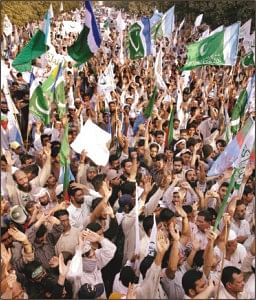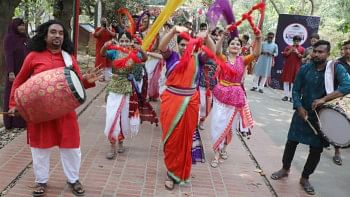Pakistan: From religious politics to religious extremism Part-II

THE fall of Kabul to the CIA-ISI sponsored Mujahideen forces in 1992 after eleven years of civil war was considered a great victory of the religious forces and of the government of Pakistan. However, the vicious power struggle between Mujahedin factions led to a civil war that devastated Afghanistan the second time. As the Mujahedins were busy fighting a new force composed of young Madrassa students, known as the Taliban (Students), came sweeping from Pakistan's border all the way to Kabul in 1996. The Taliban were recruited from Afghan refugee camps, indoctrinated in Pakistani madrassas, and trained and equipped by the ISI. Darul Uloom Haqqania, a madrassa in Akora Khattak, about 40 miles west of Peshawar, run by Maulana Samiul Haq, a JUI leader, claimed to have provided most of the Taliban recruits and the leadership. Meanwhile, the Madrassas across Pakistan had no shortage of students especially from poor rural background for whom free lodging, food, as well as some education was far better than being jobless and hungry at home. Many of these students have routinely been recruited by the Jihadi organisations to go to Kashmir or inside India to spread the Jihad. Some of them are now turning against their own government as suicide bombers or assassins. It has been reported that the poor parents with a number of sons are pressured to give one or two sons in the way of the Allah i.e. become a Jihadi. The parent's refusal could bring shame and harassment, and if they agree, financial inducement follows. Interestingly, the Mullahs or their children never decide to become a Mujahid or a suicide bomber; always the poor are sacrificed on the altar of God.
Although the Taliban government controlled 90% of Afghanistan, it was recognised by only three sponsor countries, namely: Pakistan, UAE and Saudi Arabia. Pakistan was looking forward to a titular government in Afghanistan that would not raise the Pakhtunistan issue. A pliable government in Kabul would mean Pakistan could then concentrate on Kashmir and the rest of India. Elected prime ministers such as Benazir Bhutto (1988-90, 1993-96) or Nawaz Sharif (1990-93, 1997-99) could not alter the Islamists power structure in Pakistan. In fact, Benazir was the Prime Minister when the Taliban were installed in Kabul. Like many, she believed that the Taliban would stabilise the situation in Kabul and would open up Pakistan's trade and commerce route to Central Asian Republics. The Taliban rule in Kabul was brutal, archaic and arbitrary and brought nothing but shame on the Islamic community. Meanwhile, inside Pakistan, especially in the North western tribal belt, the Taliban influence grew and by the end of 1990s they came to represent the legal authority. Successive Pakistani government chose to conform and compromise with the Taliban. Although after 9/11, President Musharraf became an active partner with the US in its War on Terror, he maintained a cosy relationship with the religious parties at home. He needed the support of the Mullahs because most of the mainstream politicians had deserted him. Muttahida Majlis-e-Amal (MMA), a cocktail of religious parties, had established a theocratic fiefdom in the NWFP. While Pakistan government was aiding the American forces in their war in Afghanistan, JUI Chief Maulana Fazlur Rahman sent thousands of armed volunteers to fight alongside the Taliban. The Maulana led the convoy in full view of the world media, but when faced with the northern army in the Jalalabad, quickly returned to Pakistan leaving his ragtag army to massacre.
The Al-Qaeda and Taliban, after being pushed out of Afghanistan in 2001, infiltrated into FATA as well as major cities of Pakistan. Large Pashtun migrant population in cities such as Karachi have turned these into their safe haven. They are using Pakistan as their rear areas to regroup, recuperate and rearm. Arrest of Khalid Sheikh Muhammad, a top Al-Qaeda leader, from Rawalpindi in March 2003 showed how terror network are using Pakistani heartland to launch their operations. Other top-level Al-Qaeda leaders arrested included Abu Zubaida and Abu Faraj Al-Libbi, both connected with worldwide terror operations. After early successes against the Taliban and Al-Qaeda forces in 2001-03, there was a let up both from the Afghan-NATO side as well from Pakistan. The Taliban and Al-Qaeda used the intervening period to regroup and rearm. The formation of Muttahida Majlis-e-Amal (MMA) government in NWFP in 2002 only helped the rehabilitation of Al-Qaeda and Taliban in Pakistani soil. MMA actually implemented the Taliban's agenda banned co-education, put women inside Burqa, banned music, movies and videos, and dispensed harsh Islamic justice to the poor. MMA, of course, were not capable of addressing the issues of illiteracy, backwardness, unemployment and poverty. The poor suffered while the rich just left with their capital. It is no wonder that in the election in 2008, the religious parties suffered their worst defeat. In the NWFP, the leftist Awami Nationalist Party (ANP) bagged the largest numbers of 31 seats while the religious MMA got only 9 seats. Nationally, the religious parties did even worse; they got only 3 seats out of 258 contested. People gave their verdict with the ballot, but then these religious parties never believed in democratic process anyway.
The Government's use of force since 2007 to dislodge the extremists from the border areas ran into trouble because the Army, equipped and trained to fight a conventional battle in the plains of Punjab or the desert of Sindh, was not battle ready to fight an insurgency in the rugged hills of Hindukush. The paramilitary forces that were initially assigned were pathetically under-armed to withstand a determined enemy. Many among them, especially the Pashtuns, were sympathetic with the Taliban and often, large numbers of them surrendered without a fight. There were allegations at home and abroad of elements within the military, especially ISI, having retained connection and sympathising with the Taliban-Al-Qaeda. Large numbers of Pakistani forces were taken prisoners and were exchanged for Taliban prisoners or huge cash. Videos of beheading of the Pakistani soldiers by the Taliban sent a chill of terror among the troops fighting there. Meanwhile, the Taliban, with assistance of extremist political parties and various militant organisations inside Pakistan have created a battlefield that has no frontiers. Frankenstein's monster has come back to haunt its creator.
Ironically, within the Pakistani ruling establishment, including the military, there is not enough realization of the grave and imminent danger. They are still preparing for the hypothetical war against India. Latest modernization plan of the armed forces is directed towards the conventional warfare rather than the unconventional one that is raging at present. Pakistan air force has signed a deal for 100 air superiority fighters for bringing parity with Indian Air Force whereas its own bases are now vulnerable to attack by the militants. The Navy is buying Submarine to, probably, search and destroy underwater Taliban! However, since the American's have clearly spelt out that they were going to hunt down the Taliban-Al-Qaeda wherever they might be, the Pakistan military have finally moved in earnest to fight the Taliban in the FATA and NWFP. Recent reshuffle within the ISI also indicate a change of direction. Meanwhile, homegrown extremist organizations are off the radar screen for the time being, but they are all bidding for their time.
The last election ushered in new hopes for Pakistan. People voted out the religious parties and gave their verdict for a progressive, democratic Pakistan. Now it is up to the politicians to guide the nation out of the chaos into which the Mullah-Military nexus has led them. There is much to be done immediately. The Taliban-Al-Qaeda axis has to be defeated militarily, politically and ideologically. The need for a joint NATO-Afghan-Pakistan command and operational structure is immediate. As long as the terrorists operate freely across the ill defined and porous Pak-Afghan border, Pakistan cannot strongly argue against the NATO-Afghan forces crossing its border in hot pursuit or launching attack on leadership targets at short notice. It would be in the interest of Pakistan to cooperate with the partners. On the political front the religious parties must be isolated and not be allowed to ride on others' shoulders and re-enter the main stage. The government needs to make people understand that religious extremism leads to violence and terror and that it jeopardizes development and progress. Especially in the tribal belt, there is much to be done on the socio-economic front. The ANP in power provides a window of opportunity that everyone must utilize. There is a need to bring all the Madrasasas under government control and carry out a review of the academic programme. Sayid Qutub and Maududi should be replaced by Al-Farabi, Ibn-Khaldun, Rumi and Iqbal. Inclusive Islam that encourages peaceful co-existence must be encouraged as opposed to exclusive Islam that espouses violence. There is a need to review the textbooks in the mainstream schools too to rid them of extremist contents. The government must ensure better educational opportunity for the poor, so that the poor youth do not fall victim to the manipulation of the religious fanatics. On the ideological front, the government needs to combat the creeping influence of radical Islamic ideology from the ME. There must be effective anti-money laundering mechanism to monitor the flow of money into and within the country to deny finance to religious extremists or their front institutions. The list of priorities can be long, yet they are urgent. The Civil Society in Pakistan is clamouring for a change from religious orthodoxy to religious enlightenment. People have already spoken by rejecting religious extremism on the Election Day. Now it is up to the government to steer the nation towards a peaceful future. A failure now will spell disaster for all of us in South Asia.
Part I appeared on 18 Oct, 2008.
The author is a freelancer.

 For all latest news, follow The Daily Star's Google News channel.
For all latest news, follow The Daily Star's Google News channel. 



Comments